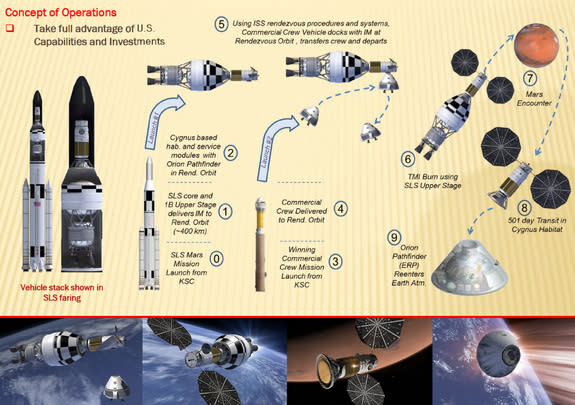For the past couple of months, many of us in space circles were waiting for more details on entrepreneur Dennis Tito's "Inspiration Mars" concept, and in the last week, they were revealed.
In what is surely a case of ironic timing, we may have been handed a turkey of sorts.
Tito's plans are contingent upon a partnership with NASA. In fact, it relies upon the US government buying into the plans and helping to fund the project. Tito's group is convinced that the mission is possible for less than $1 billion USD, of which the US government would pay a healthy chunk of.
For those following the mission, the idea is simply this; it will carry two explorers (I hesitate to use the word astronaut or any other naut for that matter) on a fly-by of the planet Mars. It uses a mixture of NASA and commercial spacecraft design, and on paper, looks possible.
 |
| Behold, Inspiration Mars. Image courtesy Space.com |
The question is whether the US government is willing to foot the bill. Of course, there are other concerns. This concept relies heavily upon untried hardware. There is the question of safety. And of course the question as to why just a fly-by, why not press for a landing?
The biggest hurdle, though, considering all those concerns, is the date; he would like to be able to do this by 2018.
That's really not that far away.
As optimistic as I'd like to be, I just do not see how this is possible. We're talking four years from now.
------------------------------
The idea of human crewed interplanetary fly-bys goes back to the beginning of the "space race". Some of the better mission concepts grew out of the Apollo program, and borrowed heavily from that hardware heritage. In 1965, McDonnell/Douglas proposed a fly-by that would utilize four Saturn V launches, with three carrying into orbit fully fueled S-IVB. These would be assembled in tandem to form a booster stage. A fourth Saturn launch would carry up the last component, another S-IVB and the Apollo/Mars portion of the space craft. Total length of time for building the spacecraft on orbit would be thirty days. Mission duration would be 655 days. They believed it could be done by 1974.
 |
| The McDonnell/Douglas Mars Mission, visualized, 1974. Drawing by Robert Little |
The closest the spacecraft would get to the Red Planet would be 3000 miles. That is a lot further than Tito's 100 mile fly-by.
As the Apollo-derived ship would fly-by Mars, it would deposit a large unmanned lander. This has since been done, repeatedly, using robotic craft. This has proven to be a far cheaper alternative.
There were other fly-by concepts. One my favorite's is a model kit, the "Pilgrim Observer", which was released by MPC in the early 1970's. It was a large NERVA powered spacecraft that would be launched on a single Saturn V, and then proceed to dive towards the planet Venus, and then outwards towards Mars, finally returning to Earth. It had other advantages that the aforementioned Apollo derived mission did not. It had three lobes that would deploy, and the whole spacecraft would then spin to produce centrifugal force, supplying artificial gravity to the twelve person crew. It would carry a telescope. It also had an "Apollo M" module, a small service craft. All this, and simply a fly-by mission.
 |
| The Pilgrim Observer, an interplanetary mission unhindered by reality. Image courtesy Round 2 Models |
Of course, when you are dealing with a model, you have plenty of creative license.
Dennis Tito and his Inspiration Mars Foundation are not planning a model, though they are certainly creative. It is this project's ambition that may be its undoing. This 501 day mission may never leave the ground, but you certainly can't fault them for their creativity.
------------------------------
On a personal note, I remain skeptical. Our own government is retreating from human spaceflight. The argument has been made that robotic missions are far cheaper, and have accomplished quite a bit. Still, the romantic notion that the Inspiration Mars project presents is alluring, and who is to say, I could be wrong. I just doubt that not only will our government shy away, I suspect that this might prove far more daunting than expected.
Still, we can dream.
No comments:
Post a Comment